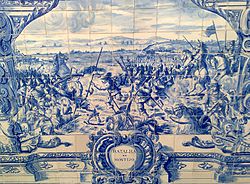Battle of Montijo
| Battle of Montijo | |||||||
|---|---|---|---|---|---|---|---|
| Part of Portuguese Restoration War | |||||||
 The Battle of Montijo (Military Museum of Lisbon) |
|||||||
|
|||||||
| Belligerents | |||||||
|
|
|
||||||
| Commanders and leaders | |||||||
| Matias de Albuquerque |
Baron of Mollingen Marquis of Torrecusa |
||||||
| Strength | |||||||
| 6,000 infantry and 1,100 cavalry (6 guns) | 4,000 infantry and 1,700 cavalry (2 guns) | ||||||
| Casualties and losses | |||||||
| 3,000 dead and wounded (disputed) or about 900 dead and captured |
433 dead 380 wounded or 3,000 dead and wounded (disputed) |
||||||
The Battle of Montijo was fought on 26 May 1644, in Montijo, Spain, between Portuguese and Spanish forces. Although the battle ended with a Portuguese victory, the Spanish saw it as a strategic success as they claimed to have prevented Matias de Albuquerque from capturing Badajoz, despite Albuquerque having no intention of attacking the city. Due to the chaotic nature of the battle, casualty figures vary.
Portuguese General Matias de Albuquerque knew the Spanish were commanded by the Marquis of Torrecusa, a renowned military tactician, and wanted to affirm his own presence. He managed to gather 6,000 infantry, 1,100 cavalry and 6 cannons, in order to give battle. He crossed the frontier attacking, pillaging and burning Vilar del Rey, Puebla and Boca de Manfarete until reaching the town of Montijo, which surrendered without a fight.
Not having encountered the Spanish army, Matias de Albuquerque decided to return to Alentejo. While on march, the Portuguese were confronted by a Spanish force from Torrecusa's army led by the Baron of Mollingen consisting of 4,000 infantry and 1,700 cavalry. On the 26th of May 1644 the two armies met not far from Montijo.
The forces of Mollingen adopted a semi circle formation, which would permit a simultaneous attack on the Portuguese front and flanks. Matias de Albuquerque, marching in a slow pace towards Portugal, had prepared for a rear attack by placing the infantry in two defensive lines with the strongest formations in the rear, the baggage wagons in the vanguard and the cavalry split between the two flanks.
The six cannons of the Portuguese initiated the hostilities, the Spanish side soon replied, but very ineffectively. The Spanish cavalry attacked the Portuguese left flank, routing the 150 Dutch cavalry commanded by Captain Piper. The panic spread to the rest of the cavalry on both flanks who abandoned the field through their own lines, taking refuge in woods near Xévora, leaving the infantry disorganized. Led by Mollingen himself, the Spanish cavalry easily opened a breach in the centre of the Portuguese positions, taking the Portuguese artillery. Thinking that the Battle was won, Mollingen troops scattered themselves without care on the field looting. Albuquerque's horse was killed and he was found fighting on foot by a French officer named Lamorlé (fighting for the Portuguese) who gave him his own horse.
...
Wikipedia
